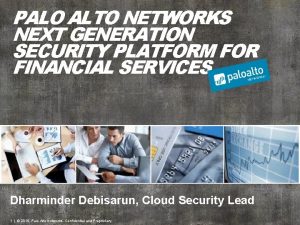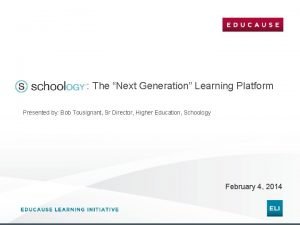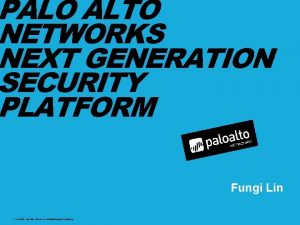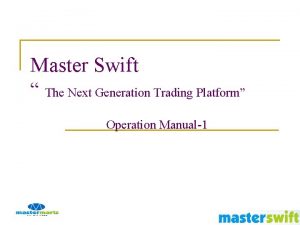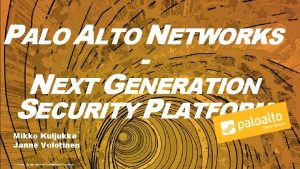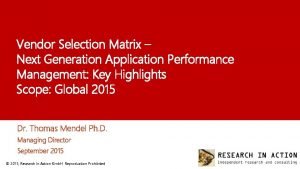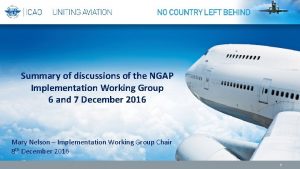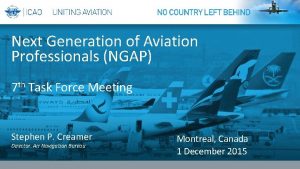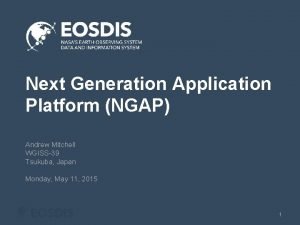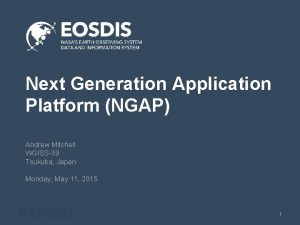Next Generation Application Platform NGAP Andrew Mitchell WGISS39









- Slides: 9

Next Generation Application Platform (NGAP) Andrew Mitchell WGISS-39 Tsukuba, Japan Monday, May 11, 2015 1

• As with most new ‘cool’ technologies, it is natural for innovative and cutting edge thinkers to want to be the first to implement a technology in their system. However, moving to quickly can sometimes lead to the scenario where you have a Solution looking for a Problem. 2

Back to the Basics: Problem Solving Loop 1. Identify the problem 2. Explore and research solutions 5. Evaluate the product 4. Develop and test 3. Select the best ideas 3

Problem: Resource Allocation of Application Deployments • Each application deployment (re)creates this process and they all deal with the same core problems. • Current application deployment can be time -consuming and expensive to scale, and maintain. Initial Platform Setup Initial Application Setup • Property • Configuration • Networks • Infrastructure Processes (e. g. Security Plans) Ongoing Maintenance & Operations • • Patching Monitoring Failover / Backups Scaling

Research Ideas: How to provide cross cutting resource management ? NASA set out to perform a Trade Study that investigates a scalable, flexible application platform solution that offers the cost benefits of hardware consolidation with the safety and security of application sandboxing and resource management. • Property – Procurement of property can take a couple months • Configuration – Setting up VM’s requires a team of system administrators, developers and database administrators. • Infrastructure Processes (e. g. Security Plans) – Heavily reliant on 3 rd party approvals. • Networks – Initial network setup and network changes to make an application available for access can take a week to occur. • Patching & Monitoring, Failover / Backups, Scaling – Analysis of monitoring logs and patching takes several hours per week, every week. Failover and Backups are only implemented for applications with a high availability need. 5

Select the Best Ideas: Use shared resources • After investigating COTS solutions and down selecting to the best fit that meets NASA’s fault tolerance, monitoring, metric, and security demands, the result of this investigation was to provide a cloud-based Platform-as-a-Service for ESDIS applications. . Initial Platform Setup • Property • Initial Application Setup Configuration • Infrastructure Processes (e. g. Security Plans) • Ongoing Maintenance & Operations Networks • Patching • • • Monitoring Scaling Backups/Failover

Develop and Test: The Next Generation Application Platform (NGAP ) • Currently developing a prototype small scale implementation (private and public cloud) of a highly available, scalable platform that can host future NASA Earth science data system services. • The beta release of the NGAP will run in NASA’s Computing Services Service Office (CSSO) General Purpose Managed Cloud Environment (GP-MCE). It will also be integrated with NASA’s Earthdata Code Collaborative (ECC) to allow for builds and releases. 7

NASA Sentinel Mirror Leveraging Existing EOSDIS Capabilities To serve US scientists, NASA is developing a data mirror archive for Sentinel 1, 3, 5 P. in the U. S. • Single network interface relieves bandwidth load on European networks • Long term archival and end user distribution by DAACs (e. g. Sentinal-1 by ASF DAAC). • Provides metric reports back to the EC/ESA on product distribution and usage • Leverages entire suite of NASA’s EOSDIS capabilities including capturing and reporting metrics on distribution and usage of Sentinel products by U. S. scientists

NASA Sentinel Gateway - NSG T F A R D Sentinel Gateway Target ————— * Ensure the reliable archive of the golden copy of Sentinel data at GSFC * Distribution to the appropriate DAAC(s) * Make that data available in AWS S 3 storage. The approach will not be limited to AWS but that is assumed to be our initial target to support NGAP. 9
